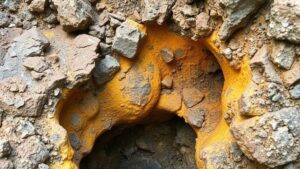Techniques for Detecting Carbonate Vein Extensions Beneath Overburden
Techniques for Detecting Carbonate Vein Extensions Beneath Overburden
Detecting carbonate vein extensions beneath overburden is crucial for various geological and mining applications. Carbonate veins, often rich in economically valuable minerals, can be obscured by surface materials, necessitating robust detection techniques. This article explores the methodologies used in locating these extensions, addressing their advantages, limitations, and the importance of integrating multiple techniques for improved accuracy.
Understanding Overburden and Carbonate Veins
Overburden refers to the layer of soil and rock that sits atop a mineral deposit. It can obstruct direct observation and assessment of the underlying geology. Carbonate veins, primarily composed of minerals such as calcite and dolomite, occur within sedimentary rocks and can serve as indicators of mineralized systems.
Common Techniques for Detection
Several techniques are utilized for detecting carbonate vein extensions beneath overburden. Each method has its own strengths and weaknesses, making it essential to apply a combination for accurate detection.
- Geophysical Methods
- Geochemical Analysis
- Remote Sensing Techniques
- Drilling and Core Sampling
Geophysical Methods
Geophysical methods, including resistivity surveying, ground-penetrating radar (GPR), and seismic reflection, offer non-invasive options for detecting geological features beneath the surface.
- Resistivity Surveying: This technique measures the electrical resistance of subsurface materials, identifying variations that suggest the presence of carbonate veins. For example, a study conducted in the Western United States demonstrated that resistivity surveys could effectively delineate carbonate formations in overburden conditions.
- Ground-Penetrating Radar (GPR): GPR uses electromagnetic waves to image the subsurface. It has proven effective in mapping the extent of carbonate veins, notably in environments with moderate overburden thickness. Case studies in limestone-rich regions highlight GPRs ability to reveal detailed structures.
Geochemical Analysis
Geochemical analysis involves sampling and analyzing surface and near-surface materials to assess mineral content and alteration patterns. This method can indicate the presence of carbonate veins through the geochemical signature they impart on surrounding soils or rocks.
- Elemental Analysis: By analyzing soil samples for elements such as calcium, magnesium, and trace metals like lead or zinc, geologists can infer proximity to carbonate veins. In regions known for base metal mineralization, geochemical soil surveys have led to successful discoveries.
- Isotopic Studies: Carbon isotopic signatures from soil or rock samples may suggest interaction with carbonate materials, providing further evidence of underlying veins.
Remote Sensing Techniques
Remote sensing employs aerial and satellite technologies to analyze surface geology from a distance, enabling broader regional assessments. Techniques such as multispectral imaging and hyperspectral analysis can identify mineralogical compositions indicative of carbonate presence.
- Multispectral Imaging: These systems capture data across various wavelengths, helping to distinguish between different rock types and mapping potential carbonate exposures on the surface.
- Hyperspectral Analysis: This advanced imaging technology provides detailed spectral information to detect subtle mineral associations often related to carbonate formations.
Drilling and Core Sampling
Ultimately, drilling remains the most definitive method for confirming the presence of carbonate veins. Core samples retrieved from drilling can be examined for mineral composition and structural characteristics, providing the clearest evidence of carbonate vein extensions.
- Diamond Drilling: This method yields high-quality core samples and is particularly effective in regions with significant overburden. The analysis of these samples can reveal the depth and width of carbonate veins.
- Reverse Circulation Drilling: This cost-effective drilling technique allows rapid sampling and real-time analysis of subsurface materials, useful in initial exploration phases.
Integration of Techniques
In practice, an integrated approach that combines geophysical, geochemical, remote sensing, and drilling techniques often yields the best results in detecting carbonate vein extensions. For example, initial geophysical surveys can pinpoint areas for focused geochemical sampling, which can then inform targeted drill sites. Such a multifaceted strategy improves both the efficiency and effectiveness of exploration efforts.
Conclusion
Detecting carbonate vein extensions beneath overburden is critical for successful mineral exploration and resource management. By employing a diversified suite of techniques, geologists can increase the likelihood of identifying these valuable geological features. The combination of non-invasive surveys with direct sampling methods creates a robust framework for exploration, ultimately leading to cost-effective and accurate mineral assessments.
As technology advances, the methods of detecting carbonate vein extensions will continue to evolve, offering new opportunities for exploration in challenging geological settings.


